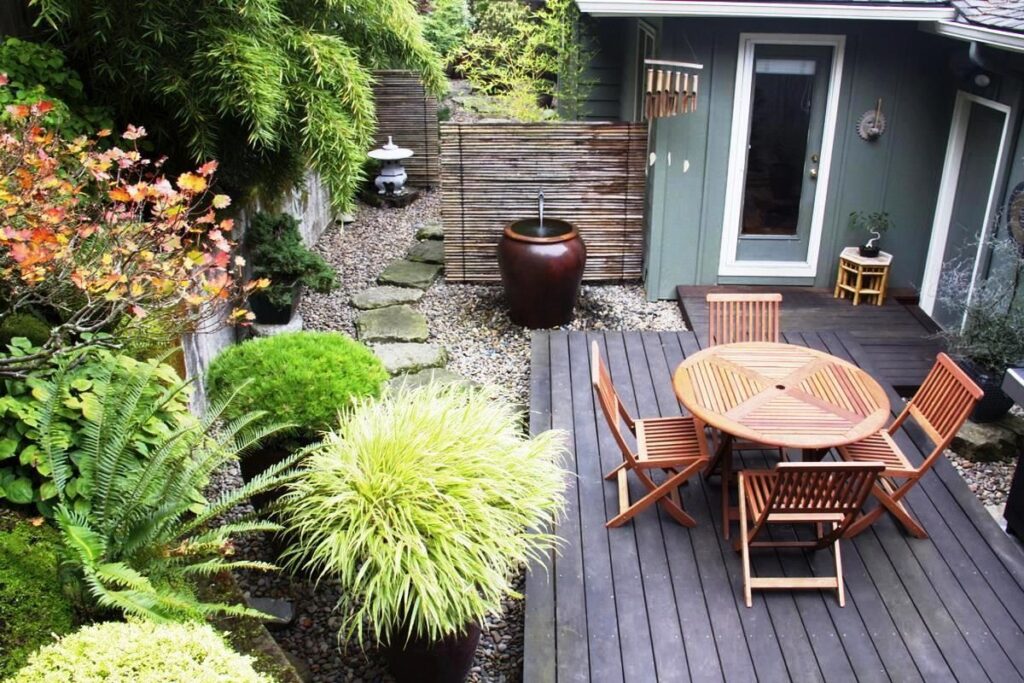Creating a sustainable backyard not only benefits the environment but also enhances your outdoor living experience. By incorporating eco-friendly practices, you can transform your backyard into a thriving, low-maintenance oasis that conserves resources and supports local wildlife. Here are some ideas to help you design an eco-friendly outdoor space that’s both beautiful and sustainable.
1. Native Plant Landscaping
Using native plants is a cornerstone of sustainable gardening:
- Choose Native Species: Native plants are well-adapted to your local climate and soil, requiring less water, fertilizer, and maintenance. They also provide essential habitat for local wildlife, including birds, bees, and butterflies.
- Create a Pollinator Garden: Plant a variety of flowering native plants that bloom at different times throughout the year to support pollinators. Avoid using pesticides, which can harm beneficial insects.
- Reduce Lawn Area: Lawns typically require a lot of water and maintenance. Replace some or all of your lawn with native plants, ground covers, or wildflower meadows to create a more sustainable landscape.
2. Water Conservation Techniques
Reducing water usage is key to maintaining an eco-friendly backyard:
- Install a Rainwater Harvesting System: Collect rainwater from your roof in barrels or cisterns and use it to water your garden. This reduces your reliance on municipal water and helps prevent stormwater runoff.
- Use Drip Irrigation: Drip irrigation systems deliver water directly to the roots of plants, minimizing evaporation and waste. Set up a timer to water during the early morning or late evening when temperatures are cooler.
- Mulch Your Garden Beds: Mulching helps retain soil moisture, reduce weed growth, and improve soil health. Use organic mulches like wood chips, straw, or leaves to enhance sustainability.
3. Sustainable Hardscaping
Choose eco-friendly materials and designs for your hardscaping:
- Permeable Pavers: Opt for permeable pavers for walkways and patios. These allow water to seep into the ground, reducing runoff and promoting groundwater recharge.
- Recycled Materials: Use recycled or reclaimed materials for your hardscaping projects, such as salvaged bricks, reclaimed wood, or recycled concrete. These materials reduce waste and have a lower environmental impact.
- Solar Lighting: Install solar-powered lights along pathways, garden beds, and seating areas. Solar lights are energy-efficient, easy to install, and eliminate the need for electrical wiring.
4. Composting and Soil Health
Healthy soil is the foundation of a sustainable garden:
- Start a Compost Pile: Composting organic kitchen scraps, yard waste, and leaves reduces waste and provides nutrient-rich compost for your garden. A compost pile or bin is easy to maintain and keeps organic materials out of landfills.
- Use Organic Fertilizers: Enrich your soil with compost and organic fertilizers, which improve soil structure and promote healthy plant growth without the harmful chemicals found in synthetic fertilizers.
- Plant Cover Crops: If you have a vegetable garden, consider planting cover crops like clover or rye during the off-season. Cover crops prevent soil erosion, improve soil fertility, and suppress weeds.
5. Wildlife-Friendly Features
Create a backyard that supports local wildlife:
- Bird and Bat Houses: Install birdhouses, bat boxes, and feeders to attract and support local wildlife. Birds and bats help control insect populations naturally.
- Create a Wildlife Pond: A small, natural pond provides habitat for frogs, insects, and birds. Avoid using chemicals in or around the pond, and plant native aquatic plants to maintain a healthy ecosystem.
- Leave Some “Wild” Areas: Designate a section of your backyard as a wild, untamed area where native plants can grow freely. This area can serve as a habitat for pollinators, insects, and small animals.
6. Sustainable Outdoor Living Spaces
Design your outdoor living areas with sustainability in mind:
- Use Eco-Friendly Furniture: Choose outdoor furniture made from sustainable materials like recycled plastic, bamboo, or FSC-certified wood. These materials are durable, weather-resistant, and have a smaller environmental footprint.
- Create a Green Roof or Wall: Incorporate a green roof or vertical garden into your outdoor space. These features improve insulation, reduce energy consumption, and provide additional green space in urban environments.
- Shade and Cooling: Plant trees or install pergolas to provide natural shade, reducing the need for energy-intensive cooling. Vines and climbing plants can also help cool your home and outdoor areas by providing shade and reducing heat.
7. Energy-Efficient Practices
Implement energy-saving practices to reduce your backyard’s carbon footprint:
- Outdoor Cooking: Use a solar cooker or energy-efficient grill for outdoor cooking. These alternatives reduce reliance on electricity or fossil fuels and produce fewer emissions.
- Reduce Light Pollution: Minimize outdoor lighting to reduce light pollution and save energy. Use motion sensors, timers, or dimmers to control lighting and prevent unnecessary energy use.
- Energy-Efficient Equipment: Choose energy-efficient garden tools and equipment, such as battery-powered lawnmowers or hand tools, to reduce energy consumption and emissions.
Conclusion
Creating an eco-friendly backyard is a fulfilling way to contribute to environmental conservation while enjoying a beautiful and functional outdoor space. By incorporating native plants, conserving water, using sustainable materials, and supporting local wildlife, you can design a backyard that’s not only good for the planet but also a joy to spend time in. These ideas will help you build a sustainable outdoor environment that thrives year-round with minimal impact on the earth’s resources.



